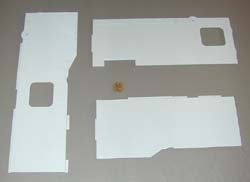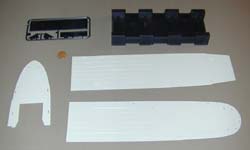Trumpeter 1/350 USS Essex CV9 | | Introduction Trumpeter's second large-scale injected carrier has been eagerly anticipated since their release of the Hornet in late 2002. I was delighted when this review copy arrived in the mail. A 1/350 scale injected kit of CV9 USS Essex! Will the Essex live up to the recently released Trumpeter Hornet? I believe it does with room to spare! Read on. Background Essex (CV-9) was launched 31 July 1942 by Newport News Shipbuilding and Dry Dock Co. She was the first of the powerful Essex class fast fleet carriers that dominated the Pacific war till its conclusion. She was reclassified (CVA-9) on 1 October 1952, and (CVS-9) on 8 March 1960. Following her shakedown cruise Essex sailed to the Pacific in May 1943 to begin a succession of victories, which would bring her to Tokyo Bay. She participated in virtually every carrier operation in 1943. In 1944 Essex proceeded to San Francisco for her single wartime overhaul. For the remainder of 1944 she continued her frontline action, participating in strikes against Okinawa, Formosa, and took part in the battle for Leyte Gulf. While attacking Manila and the northern Philippine Islands during November, for the first time in her far-ranging operations and destruction to the enemy, Essex received injury. A kamikaze hit the port edge of her flight deck landing among planes fueled for takeoff, causing extensive damage, killing 15, and wounding 44. This "cramped her style" very little. Following quick repairs Essex supported every major action till the end of the war as part of TG 58. Following the surrender, she continued defensive combat air patrols until she was ordered to Bremerton, Wash., for inactivation. On 9 January 1947 she was placed out of commission in reserve. Modernization endowed Essex with a new flight deck, and a streamlined island superstructure, on 16 January 1951 after which she participated in four tours of duty in the Korean conflict. She was the first carrier to launch F2H "Banshee" twinjet fighters on combat missions. In July 1955 Essex entered Puget Sound Naval Shipyard for repairs and extensive alterations, including installation of an angled flight deck. Modernization completed, she served as an anti-submarine carrier. On 10/22/68 the Essex recovered Apollo 7 spacecraft and crew. Sadly, she was scrapped on 15th June 1975. Essex received the Presidential Unit Citation, and 13 battle stars for World War II service and 4 battle stars and the Navy Unit Commendation for Korean War service. The Kit  This review kit arrived bagged rather than in its retail box. Most of the 11 frets and numerous large free components are molded in hard light gray styrene. One is immediately impressed with the size of this model! The waterline hull is one piece! I can't imagine the size of the tool used to create this part. The kit can be built either as a waterline representation or full hull. A one-piece waterline hull base is molded in dark red. The lower hull is likewise. I had to test fit the hull pieces and was delighted at the fit (far better than the Hornet). There will be some filling and sanding here sure, but it doesn't look like much trouble. There has been Internet chatter about the heavy bow on the Hornet kit. The Essex bow is thin and beautiful! This review kit arrived bagged rather than in its retail box. Most of the 11 frets and numerous large free components are molded in hard light gray styrene. One is immediately impressed with the size of this model! The waterline hull is one piece! I can't imagine the size of the tool used to create this part. The kit can be built either as a waterline representation or full hull. A one-piece waterline hull base is molded in dark red. The lower hull is likewise. I had to test fit the hull pieces and was delighted at the fit (far better than the Hornet). There will be some filling and sanding here sure, but it doesn't look like much trouble. There has been Internet chatter about the heavy bow on the Hornet kit. The Essex bow is thin and beautiful! Large Components  The flight deck is molded in three large pieces. This normally would make me cringe but dry fitting again showed good fits. Just a touch of well-masked filler would make seems disappear. I recommend masking here because all flight deck surfaces feature very fine scribed detail representing acres of tie downs and one catapult. All three elevators can be posed in either a raised or lowered position. The flight deck is molded in three large pieces. This normally would make me cringe but dry fitting again showed good fits. Just a touch of well-masked filler would make seems disappear. I recommend masking here because all flight deck surfaces feature very fine scribed detail representing acres of tie downs and one catapult. All three elevators can be posed in either a raised or lowered position.  The hanger deck is very well represented in three large parts. The fore deck has nicely done stanchions and miniscule molded in anchor chains. These should be easy to remove and replace with better anchor chains. The middle hanger deck piece features a nicely scribed deck. The hanger deck should really shine with a couple of aircraft strategically parked. The afterdeck has a nicely molded deck details. The hanger deck is very well represented in three large parts. The fore deck has nicely done stanchions and miniscule molded in anchor chains. These should be easy to remove and replace with better anchor chains. The middle hanger deck piece features a nicely scribed deck. The hanger deck should really shine with a couple of aircraft strategically parked. The afterdeck has a nicely molded deck details. Essex comes equipped with the same massive base piece and placards, as did the Hornet. On the Trees Trees A and B contain most of the under flight deck ship's bulkheads, catwalks, and ladders. Surface detail features are finely scribed. Numerous portholes line the surfaces should probably be drilled out during assembly. Hatches have very fine latch detail molded in! Hanger deck doors are all molded closed with nicely represented corrugated doors. One might think they would leave a few open to show off the hanger deck. I may cut open one or two. Trees C and D contain most of the rest of the ship's bulkheads, intermediate decks, flight deck fore and aft pieces, gun platforms, and screws. The gun platforms have molded in details and underside supports are nicely represented. Trees E and F contain parts for the large island, elevators and the rudder. There are two large slab sided halves that are rife with surface detail. The various decks slide into the main island pieces and feature gun mount detail and nicely thin splinter shielding. The masts are near scale thickness. Radar antennae are molded solid with fine grids molded in. I would recommend replacing them with PE parts. The rudder has fine scribed panel detail. The ship's boat (one) is well molded with cockpit detail. Tree G is duplicated and contains most of the ship's detailed parts. These include aerials, guns, directors, ship's screws, drive shafts, and cranes. The 20mm guns are a tad heavy for the scale. There are no gun shields but PE would really dress these up. The 10 quad 40mm AAA mounts and guns can be posed and the open five-inch guns are well molded. The quad 40mm guns are very well done with scale barrels and cooling jackets. The ship's cranes are nicely represented without being overly heavy. The ships screws are nicely shaped and very usable. The twin five-inch turrets are particularly nice and feature molded in blast bags. The radio masts are molded solid and would best be replaced with PE parts. The Air Wing Trees J, L, and N contain the kit aircraft. The directions point out that four of each aircraft is included in the kit though my sample contained only two [Editor's note: Oops. . busted. Sorry Richard, but they were just too darn cute and Chris has plans for them - RNP]. These include SBD Dauntless dive-bombers, F6F Hellcats, and TBF Avenger torpedo planes. This is enough to equip Essex for 1943 actions as the SBDs were phased out soon after that. The trees are done in a manner I have never seen before. Each tree is an assemblage of three different color molding! The aircraft are molded in gray, undercarriage in black, and windshields are done in clear styrene. Each aircraft has very finely scribed details even to the point of representing the fabric control surfaces. These are some of the best in-scale birds I have seen. Trumpeter offers 10 packs of these birds for those wanting a full flight deck. Directions The sample copy instructions were copies containing four pages of parts identification followed by 16 pages of instructions. No doubt Trumpeter will ship a nicely done booklet in the production kit, as is their practice. Instructions in English and Chinese run through out and are very clear. Decals One decal sheet contains markings for all parts. There are two huge number "9" decals in black for the flight deck. There are a variety of white flight deck dashes and markers. Unfortunately deck markings were normally black during the war years. My sample contained no aircraft markings though I am sure the production copy will. The decals are well registered and thin. Conclusion Going over this kit I keep flashing back and comparing it to the Trumpeter release of the Hornet last year. It compares well with the Hornet and, in many areas, betters it. This beauty should build up to an impressive (large) model right out of the box. Throw in a set of Tom's Modelworks Essex Detail Set and this should be a showstopper! I highly recommended this kit for intermediate to advanced ship builders. We would like to thank Stevens International for kindly supplying this review sample. Reference Warships Number 10: Essex Class Carriers in Action. Squadron/Signal Publications. | 








|